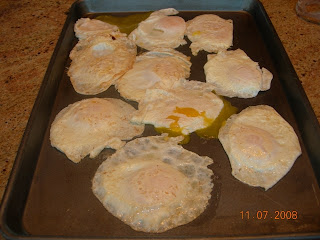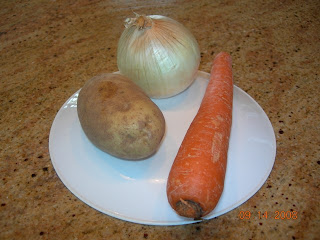


Making Memories With Food
 11:20 AM
11:20 AM
 Unknown
Unknown



 8:18 AM
8:18 AM
 Unknown
Unknown


 9:14 AM
9:14 AM
 Unknown
Unknown



 6:52 AM
6:52 AM
 Unknown
Unknown






 6:37 AM
6:37 AM
 Unknown
Unknown






 8:25 PM
8:25 PM
 Unknown
Unknown



 8:11 AM
8:11 AM
 Unknown
Unknown





 7:13 AM
7:13 AM
 Unknown
Unknown

 7:43 AM
7:43 AM
 Unknown
Unknown

You would think cooking a few vegetables wouldn't be too hard, wouldn't you? Well, you're wrong. I'm finding out more and more that all the cooking I've done since age 10 (that's 44 years) didn't prepare me for vegetable class. I couldn't recognize jicima, kohlrabi, or celery root when Chef Heather held them up in class. I was praying that those particular vegetables wouldn't be in my "mystery basket", an assignment in which we would get 3-4 vegetables to prepare, sight unseen. Guess what our mystery basket contained? Yes, kohlrabi and jicima, red Swiss chard, fennel (which I hate), and cauliflower. Our instructions for the day were to make the following:
Duxelles (finely chopped mushrooms cooked with shallots, garlic, and butter)
Stir-fried vegetables: any vegetables, any sauce, but use some vegetables from the basket
Vegetable tempura (using a vegetable in our basket, we picked cauliflower)
3-4 vegetable dishes using the vegetables in our mystery basket. We could use other vegetables set out for the class, proteins in the walk-in, and anything in the pantry.
I was very, very happy that I had done some homework by writing down several types of vegetable preparations that could be used for various vegetables. This came in very handy because we were told we could use recipes from our text book, look on the Internet in the office, etc. It would have been a lot harder to start looking for ideas with the time crunch effect.
We decided to make Asian slaw with the fennel and jicima, Thai curry style vegetables using the kohlrabi, Swiss chard with bacon and an egg, and then we made the stir fry using peppers, brocolli, swiss chard, jicima, and a few other vegetables. Our sauce was a hoisin, soy, garlic, ginger sauce.
As usual, the chef instructors were brutal. Facing the presentation table is nerve-wracking. You know they will find something wrong with every dish and they do. Their comments are very helpful, even if they sting. Too much slaw in a too small bowl, not enough flavor; too much bacon in the Swiss chard (but it tasted very good), egg on top overcooked; stir fry had too many uneven cuts of vegetables; curry was flavorful but carrots were undercooked, but overall our dishes were creative and tasty. We get credit for using so many ingredients and picking somewhat complicated dishes.
I learned a lot, particularly that when you're pressed for time to come up with ways to cook food your mind will go blank, so be prepared ahead of time. Even then, finding all the ingredients you need is not so easy, and watch the cooking times when using many different vegetables.
Next week is Poultry class. I plan to buy a half dozen chickens and practice!
 6:23 AM
6:23 AM
 Unknown
Unknown



 5:39 AM
5:39 AM
 Unknown
Unknown



 4:24 PM
4:24 PM
 Unknown
Unknown
 1:20 PM
1:20 PM
 Unknown
Unknown
 8:17 PM
8:17 PM
 Unknown
Unknown




 9:08 PM
9:08 PM
 Unknown
Unknown




 3:46 PM
3:46 PM
 Unknown
Unknown
 3:55 PM
3:55 PM
 Unknown
Unknown

 RSS Feed
RSS Feed Twitter
Twitter



